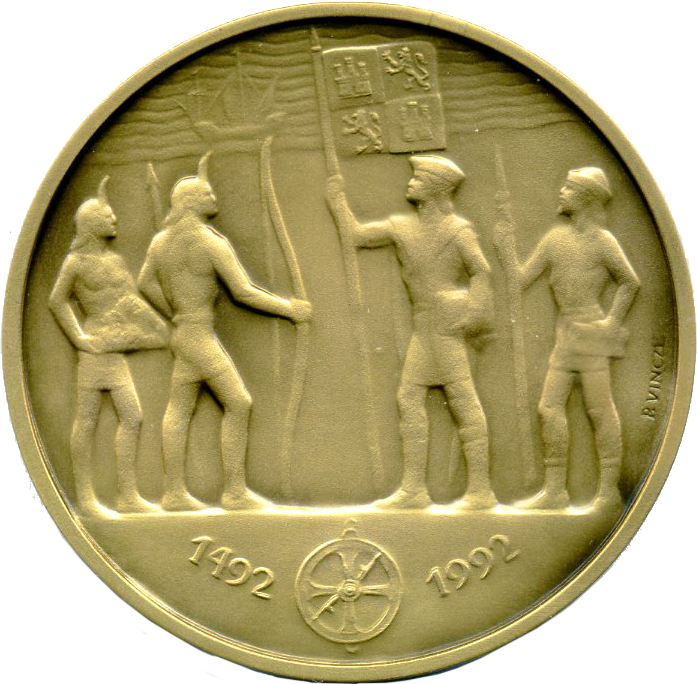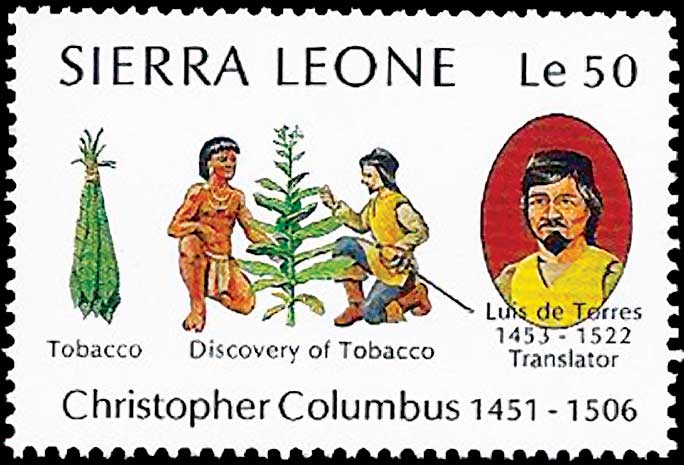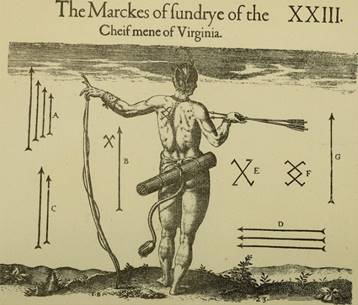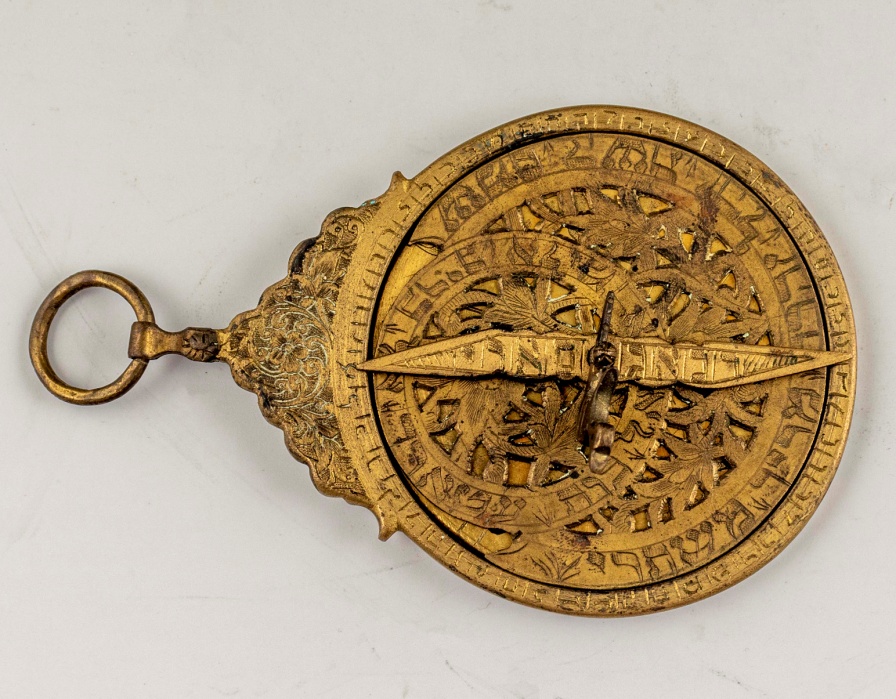 |  |
Medal issued in 1992, designed by Paul Vincze, struck by J. Jenkins Sons in quantities of 350 bronze, 120 pure silver and
12 10kt gold. Obverse: Portrait, Christopher Columbus Quincentennial 1992, AFTER YOU EXPELLED THE JEWS YOUR MAJESTIES SENT ME WITH A FLEET Ch Columbus (signature), P. VINCZE. Reverse: Columbus, accompanied by Luis de
Torres, meets Arawaks in the New World, astrolabe below, 1492 1992, P. VINCZE. 58 mm.
Spanish Expulsion (1492)
The history of Spanish (Sephardic) Jewry goes back at least 2,000 year to the time of the Roman Empire. The first anti-Jewish laws were passed in 589 CE, when it was ruled that children of a mixed Jewish-Christian marriage should be baptized … and this soon led to a policy of forced conversion of all Jews in the kingdom.
In 1694, the 17th Council of Toledo declared that: “[Jews] shall be deprived of their property for the benefit of the exchequer, and shall be made slaves forever. Those to whom the King sends them as slaves must watch that they may no longer practise (sic) Jewish usages, and their children must be separated from them, when they are seven years of age, and subsequently married with Christians.” In the period of Arabic rule (after 711 CE), the Jews of Spain fared better ― scholarship and culture flourished.
Beginning in 1478, in the reign of Ferdinand and Isabella, no less than 13,000 secret Jews (conversos) were executed by the Inquisition. At the same time, the monarchs continued to employ Jewish functionaries, such as Don Isaac Abravanel, and conversos like Luis de Santangel, in their court. On March 31, 1492 the Edict of Expulsion was signed, resulting in 300,000 Sephardic Jews leaving for refuge in North Africa, Turkey, etc. Dr. M. Kayserling (Christopher Columbus) writes: “[The object was] to secure the property of the secret Jews for the state treasury … [and to] confiscate the property of those who openly professed to be Jews.”
The last Jews left Spain on August 2, 1492, the day before Columbus sailed; that was also the traditional day of mourning (9th of Av) for the destruction of the First and Second Temples. The first words Columbus wrote in his log were: “After you expelled the Jews your majesties sent me with a fleet;” and these words are inscribed on the Jewish-American Hall of Fame medal. The reason that Santangel, a wealthy member of a converso family, loaned most of the money for Columbus’ voyage, “must [have been] the desire to help his persecuted brothers ― from whom he still felt linked ― [find a new homeland],” speculates Simon Wiesenthal (Sails of Hope, the Secret Mission of Christopher Columbus).
Columbus’ second voyage to the “New World,” starting on September 24, 1493, with 17 ships and about 1200 men, was paid for entirely by the gold and other valuables confiscated by Spain from the expelled Jews.
Luis de Torres (? – 1493)
The only known Jew on Columbus’ voyage was Luis de Torres, though he had to be baptized just a day before sailing. Torres was born Yosef Ben Ha Levy Haivri (“Joseph the Son of Levy the Hebrew”). Torres knew Hebrew, Aramaic and some Arabic. Simon Wiesenthal speculates (Sails of Hope) that “after the landfall in America, the first words addressed to the natives were Hebrew.”
On the medal, the Arawaks are shown bearing gifts to Columbus and Torres. As Columbus wrote to his benefactor Luis de Santangel: “They are so unsuspicious and so generous with what they possess, that no one who had not seen it would believe it. They never refuse anything that is asked for. They even offer it themselves, and show so much love that they would give their very hearts.”

Torres was one of the first European settlers in the New World. When Columbus set out to return to Spain on January 4, 1493, Luis de Torres was one of 39 men left behind on Hispaniola (today ― Haiti and Dominican Republic). Sadly, when Columbus returned to the island later that year, he found that the group had been wiped out. Other stories tell that Torres settled in Cuba. The true fate of Luis de Torres remains a mystery.
Landfall (October 12, 1492)
After making landfall on Guanahani, Columbus visited five islands in the Bahamas before reaching Cuba. Unfortunately, we are not sure exactly where Guanahani was, or for that matter which were the other islands!

The portrayal of the male Arawak greeting Columbus on the medal could have been inspired by this Illustration from the Spanish letter of Columbus to Luis de Santangel, dated 15 February, 1493, reprinted from the unique copy of the original edition, printed by Johann Rosenbach. The Arawaks didn’t wear much clothing, since the Caribbean weather was always warm. Arawak men usually went naked except for special occasions, when they might wear decorative loincloths and cloaks. Arawak women wore short skirts and strands of shell necklaces. Both men and women both wore their hair long, sometimes decorated with colorful parrot feathers. (Bibliography: www.bigorrin.org)
Abraham Zacuto’s Astrolabe

Brass astrolabe with Hebrew inscriptions, unknown date.
An astrolabe is depicted at the bottom of the medal’s reverse. Rabbi Abraham Zacuto (c. 1450-1515) improved the astrolabe and made it of copper instead of previously used wooden astrolabes that were not precise enough. Zacuto’s astrolabe could be used at sea, while earlier devices were land-bound. Columbus made use of Zacuto’s improved asrolabe and his navigational tables.
The history of Spanish (Sephardic) Jewry goes back at least 2,000 years to the time of the Roman Empire. The first anti-Jewish laws were passed in 589 CE, when it was ruled that children of a mixed Jewish-Christian marriage should be baptized — and this soon led to a policy of forced conversion of all Jews in the kingdom. In 1694, the 17th Council of Toledo made all Spanish Jews slaves. In the period of Arabic rule (after 711 CE), the Jews of Spain fared better — scholarship and culture flourished.
Beginning in 1478, in the reign of Ferdinand and Isabella, no less than 13,000 secret Jews (Conversos) were executed by the Inquisition. At the same time, the monarchs continued to employ Jewish functionaries — such as Don Isaac Abravanel ¬— in their court. On March 31, 1492 the Edict of Expulsion was signed, resulting in 300,000 Sephardic Jews leaving for refuge in North Africa, Turkey, etc.
The last Jews left on August 2, 1492, the day before Columbus sailed; that was also the traditional day of mourning (9th of Av) for the destruction of the First and Second Temples. This explains the first words Columbus wrote in his log: “After you expelled the Jews your majesties sent me with a fleet.”
DNA Findings Prove that Columbus was of Jewish Ancestry